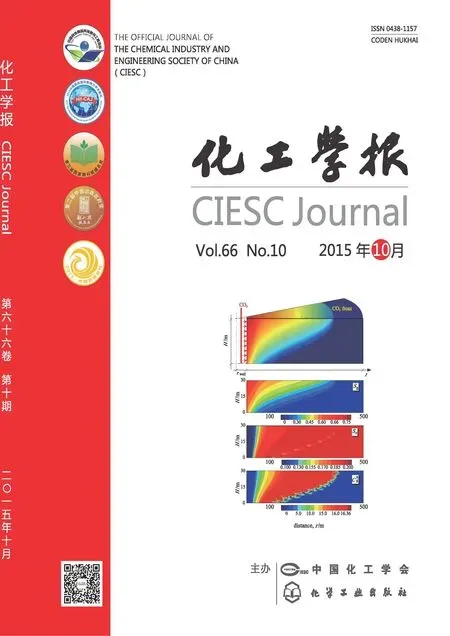交聯劑對聚乳酸流變性能及其發泡材料泡孔結構的影響
張婧婧,黃漢雄,黃耿群
(華南理工大學塑料橡膠裝備及智能化研究中心,廣東 廣州 510640)
交聯劑對聚乳酸流變性能及其發泡材料泡孔結構的影響
張婧婧,黃漢雄,黃耿群
(華南理工大學塑料橡膠裝備及智能化研究中心,廣東 廣州 510640)
在研究交聯劑對聚乳酸(PLA)流變性能影響的基礎上,采用間歇發泡方法研究交聯PLA發泡材料的泡孔結構。結果表明,交聯劑可提高低頻區PLA的損耗角正切和復數黏度以及PLA的熔體強度和拉伸黏度。交聯PLA的復數黏度高,使泡孔長大初期的長大速率較低;泡孔長大后期泡孔壁被拉伸時,熔體強度和拉伸黏度的急劇提高使泡孔壁強度增加而不會被撕裂,大大減小泡孔的合并,形成較均勻且較規則的泡孔結構。交聯PLA高的熔體強度可明顯減少發泡時二氧化碳擴散至空氣中的量,從而增加PLA發泡樣品的體積膨脹率;加入0.4 phr的交聯劑時,樣品的體積膨脹率最大(達41)。
聚乳酸;超臨界流體;聚合物加工;交聯劑;流變學;泡孔結構
引 言
聚乳酸(PLA)是一種性能優良的生物可降解聚合物,具有環境友好、成型加工性好等優點,可用于食品包裝、醫藥和汽車等領域[1-2],但PLA固有的一些缺點(如抗沖擊性差等[3])限制了其廣泛應用。制備PLA微孔發泡材料以在其內部形成大量細小且均勻的泡孔,可提高其抗沖擊,并減少材料消耗、降低產品價格。
超臨界二氧化碳(Sc-CO2)在常溫和加工溫度下均可較好地溶解于PLA中[4],這一特性使采用Sc-CO2為物理發泡劑制備PLA微孔發泡材料成為可能。但PLA的微孔發泡目前仍存在一些挑戰,如PLA熔體強度較低、PLA受熱易分解、PLA對剪切敏感等[5-8]。Di等[9]通過對PLA進行化學改性以增加分子質量,提高其剪切黏度和彈性;經采用間歇方法發泡后,泡體密度從未改性樣品的125降低至改性樣品的66 kg·m?3,泡孔平均直徑相應地從227減小至37 μm。NatureWorks公司推出熔體強度較高的發泡級PLA,利于低密度微孔發泡材料的生產[10]。已有學者對結晶、Sc-CO2含量和發泡參數對發泡PLA材料泡孔結構的影響進行了研究[11-15],但對發泡用PLA的流變性能及其對發泡性能和泡孔結構的影響的研究還較少[16]。因此,本文通過對PLA進行交聯以提高其熔體強度,制備微孔發泡PLA材料,并基于交聯PLA的流變性能分析發泡材料的泡孔結構。
1 實驗部分
1.1 原料和樣品制備
PLA:牌號2002D,美國NatureWorks公司,熔體指數為6 g·(10 min)?1(190℃/2.16 kg);交聯劑:過氧化二異丙苯(DCP),蘭州石化公司生產;成核劑:滑石粉。
PLA在80℃下干燥8 h,與DCP和滑石粉(0.5 phr)干混均勻后加入雙螺桿擠出機(直徑35 mm)進行熔融混煉、擠出切粒。擠出過程中,從機頭出口處取出部分熔體壓制成直徑25 mm、厚度約1 mm的圓片狀試樣。共制備4種樣品,其DCP含量分別為0、0.2、0.4和0.6 phr,分別記為PLA-0、PLA-0.2、PLA-0.4和PLA-0.6。
采用本課題組自制的高壓釜發泡裝置[17]制備發泡樣品。發泡步驟如下所述:用低壓CO2沖洗高壓釜;放入上述制備的粒狀PLA,加熱高壓釜至飽和溫度(120℃),穩定后往高壓釜內通入CO2至發泡壓力(15 MPa),飽和約10 h;接著升溫至160℃,穩定0.5 h后在1 s內快速卸壓至大氣壓;排出發泡樣品在空氣中冷卻。
1.2 測試與表征
采用旋轉流變儀(型號Bohlin Gemini200,英國Bohlin公司)測試上述制備的圓片狀試樣的動態流變性能;掃描頻率范圍為0.02~100 rad·s?1,剪切應變為1%。采用拉伸流變儀[18](型號Rheotens 71.97,德國G?ttfert公司)測試上述制備的4種PLA樣品的熔體拉伸流變性能;柱塞速度為0.05 mm·s?1,對應熔體所受的剪切速率為90 s?1。
將發泡樣品置于液氮中5min后,快速脆斷;對樣品表面進行噴金,采用掃描電鏡(SEM;型號Quanta200,荷蘭FEI公司)觀察脆斷面的泡孔結構。按GB/T 15223—2008標準測定發泡樣品的泡體密度。體積膨脹率為未發泡樣品的密度與發泡樣品密度的比值。
2 結果與討論
2.1 流變性能
聚合物動態流變性能中的復數黏度和損耗角正切(tanδ)影響其發泡材料的泡孔結構。圖1顯示了170℃測試溫度下4種PLA樣品的tanδ和復數黏度隨掃描頻率的變化曲線,其中tanδ表征材料黏性與彈性之比。可見,PLA的復數黏度隨DCP含量的增加而提高,且剪切變稀現象更明顯,原因是DCP分解使PLA主鏈上產生自由基活性點,導致PLA分子鏈發生一定程度的交聯[19]。對tanδ,在低頻區,tanδ隨DCP含量的增加而提高,而在高頻區則相反。原因可能是低頻時較高DCP含量樣品的交聯結構提高了樣品的黏性,導致其在低頻時黏性較高;而高頻振蕩破壞了該交聯結構,降低樣品的黏性,導致其高頻時彈性較高。
圖2所示為170℃下4種PLA樣品的拉伸力與拉伸比之間的關系曲線。本文取熔體拉伸過程中斷裂時所受拉力為PLA樣品的熔體強度。從圖2中可看出,DCP的加入對PLA熔體強度的影響較大。與未交聯PLA(斷裂時拉力約為0.010 N)相比,3種交聯PLA的拉伸力-拉伸比曲線線性段斜率較大、熔體強度較高,且隨DCP含量的增加而明顯提高(PLA-0.2、0.4和0.6斷裂時拉力分別約為0.016、0.042和0.053 N),這是因DCP使PLA分子鏈產生交聯所致。圖3顯示了170℃下4種PLA樣品的熔體拉伸黏度與拉伸應變速率之間的關系曲線。可看出,PLA樣品的熔體拉伸黏度呈明顯的拉伸變稠現象。在相同拉伸應變速率下,交聯PLA的拉伸黏度比未交聯PLA的高,且隨DCP含量的增加而提高。
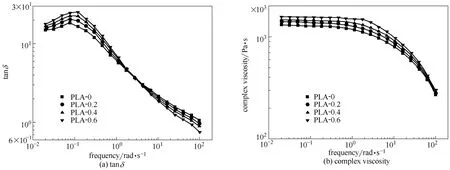
圖1 4種PLA樣品的tanδ和復數黏度與頻率的關系曲線(170 ℃)Fig.1 tanδand complex viscosityversusfrequency curves for 4 kinds of PLA samples at 170℃
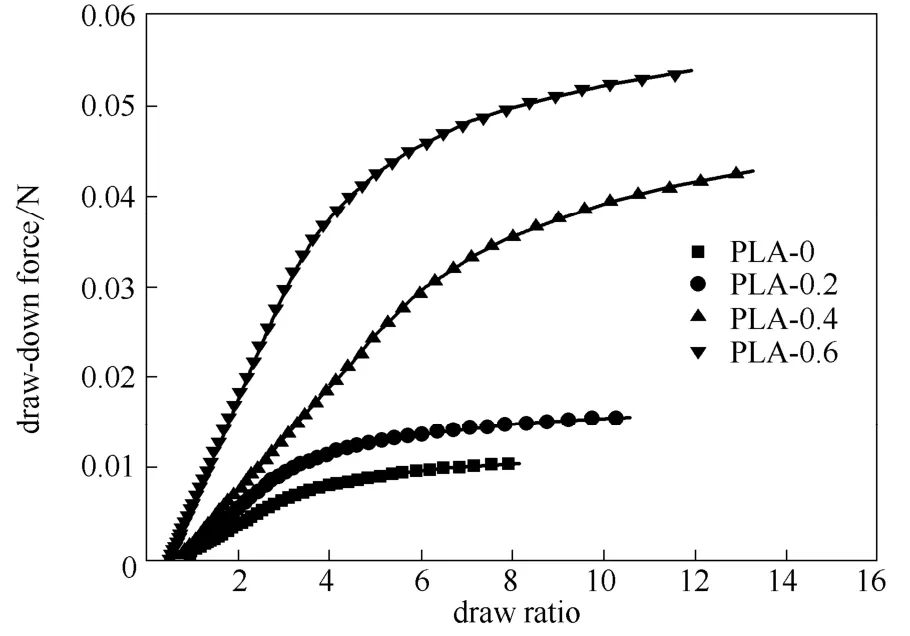
圖2 4種PLA樣品的熔體拉伸力與拉伸比的關系曲線(170 ℃)Fig.2 Draw-down forceversusdraw ratio curves for 4 kinds of PLA samples at 170 ℃
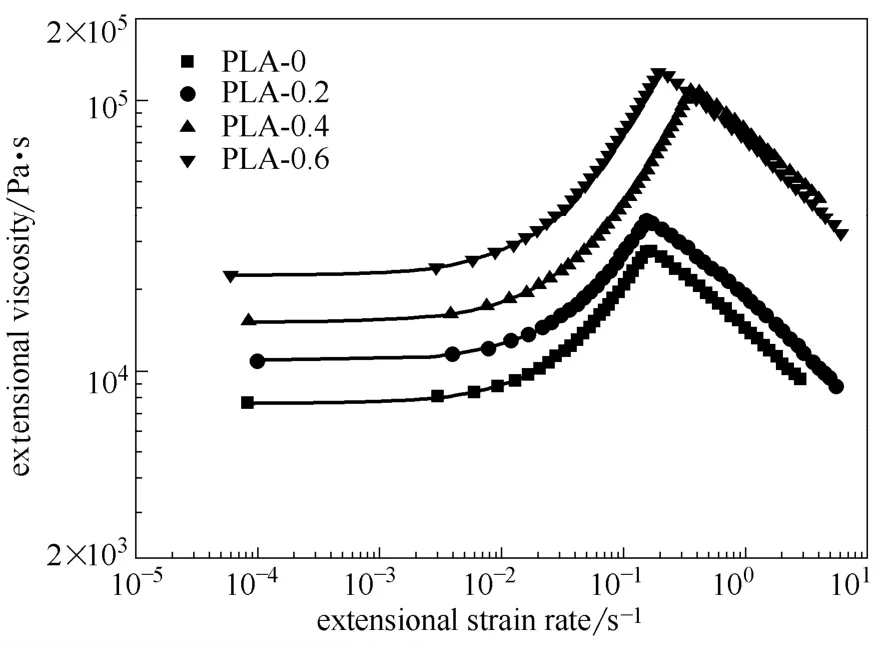
圖3 4種PLA樣品的熔體拉伸黏度與拉伸應變速率的關系曲線(170 ℃)Fig.3 Extensional viscosityversusextensional strain rate curves for 4 kinds of PLA samples at 170 ℃
2.2 泡孔結構
圖4給出了4種發泡PLA樣品脆斷面的SEM照片。顯見,發泡PLA-0(未交聯)樣品的泡孔形狀明顯不規則,泡孔尺寸分布不均勻,部分泡孔破裂而出現泡孔合并現象[見圖4(a)中圓圈標示],這與本課題組前期的研究結果[20]相似。交聯PLA發泡樣品尤其是PLA-0.4發泡樣品的泡孔形狀明顯較為規則,泡孔尺寸分布較均勻,泡孔合并現象大幅減小,其中PLA-0.4樣品的泡孔平均直徑約32 μm;發泡PLA-0.6樣品的泡孔形狀較不規則,發生泡孔合并現象,泡孔直徑增加。
為進一步分析DCP對發泡PLA樣品泡孔結構的影響,采用 SEM在較大放大倍數下觀察發泡PLA-0和PLA-0.4樣品的泡孔壁,SEM照片如圖5所示。可見,發泡 PLA-0樣品的泡孔壁存在較明顯被撕裂的現象,而發泡PLA-0.4樣品的泡孔壁較光滑,未發生破裂。
有研究[9,21]表明,動態流變測試時低頻區高的復數黏度、高剪切變稀現象、高彈性和高熔體強度有利于發泡成型過程。從前面流變性能的結果可知,加入DCP使PLA低頻區的復數黏度、剪切變稀現象、拉伸黏度和熔體強度均得到提高。由于聚合物的彈性影響泡孔合并和最終泡孔結構的穩定,復數黏度影響發泡過程中的泡孔長大[20],熔體強度和拉伸黏度影響最終泡孔結構的穩定[16],所以加入DCP對泡孔長大階段有較大影響。在此階段,CO2不斷進入已形成的泡孔中,促使泡孔長大。長大過程中相鄰泡孔之間的壁被不斷地拉伸而變薄,未交聯PLA的復數黏度低,泡孔長大速率較大,但由于彈性和熔體強度低,泡孔壁強度低導致其被撕裂、泡孔合并。而交聯PLA的復數黏度高,泡孔長大的速率較小,同時彈性、熔體強度和拉伸黏度高,當泡孔壁被拉伸即拉伸應變速率增加時,拉伸黏度急劇增加,使泡孔壁強度增加而不會被撕裂,大大減小泡孔合并現象,形成較均勻且較規則的泡孔結構。當DCP含量增至0.6 phr時, PLA的復數黏度和彈性均較高,泡孔成核時受到較大的阻力而不利于形成泡核,使更多的CO2用于泡孔長大,熔體較大的彈性也增加泡孔壁強度,使泡孔持續長大,從而增加發泡樣品的泡孔直徑。
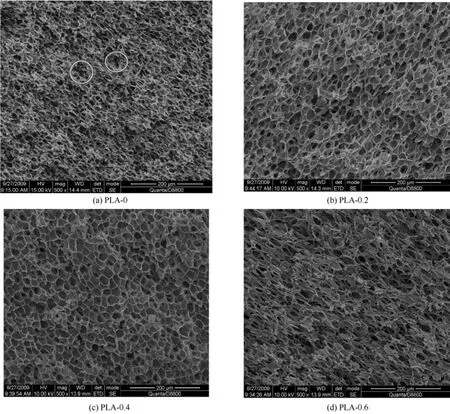
圖4 4種發泡PLA樣品脆斷面的SEM照片Fig.4 SEM micrographs of fractured surfaces for 4 kinds of foamed PLA samples
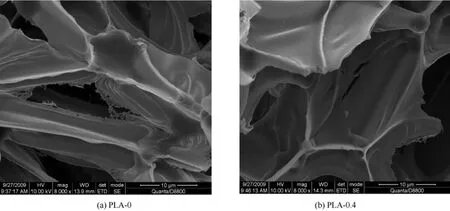
圖5 發泡PLA-0和PLA-0.4樣品局部放大的SEM照片Fig.5 SEM micrographs with high magnification for foamed PLA-0 and PLA-0.4 samples
圖6顯示了發泡PLA樣品的泡體密度和體積膨脹率與DCP含量的關系曲線。可見,加入DCP后,樣品的泡體密度減小、體積膨脹率增加,且當DCP含量為0.4 phr時,體積膨脹率最大,達41;但當DCP含量進一步增加至0.6 phr時,泡體密度有一定程度的增加,體積膨脹率有一定程度的減小。發泡材料的泡體密度和體積膨脹率主要由用于泡孔長大的CO2量決定[22]。對未交聯PLA,由于熔體強度低(圖2),發泡時樣品表層難以包裹住CO2,使樣品內的CO2擴散至空氣中的量增加,用于泡孔長大的CO2量減少,降低發泡樣品的體積膨脹率;而交聯PLA高的熔體強度(圖2)可明顯減小CO2擴散至空氣中的量,從而增加樣品的體積膨脹率;但較高的DCP含量使泡孔成核所受的阻力過大,減少泡核數,從而不利于體積膨脹率的增加。
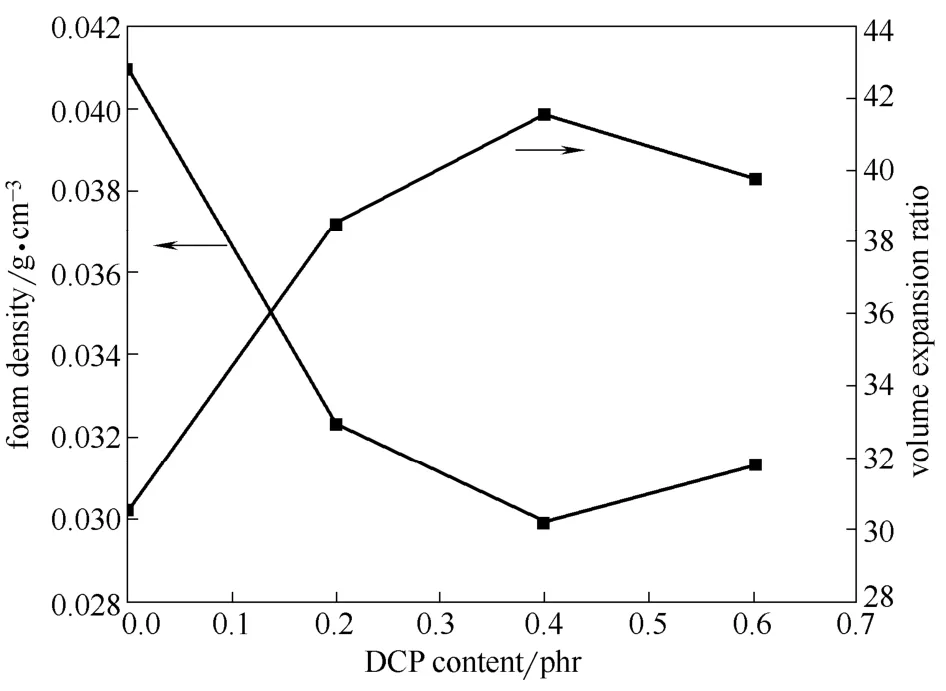
圖6 發泡PLA樣品的泡體密度和體積膨脹率與DCP含量的關系曲線Fig.6 Foam density and volume expansion ratioversusDCP content curves for foamed PLA samples
3 結 論
(1)隨DCP含量的增加,低頻區PLA的損耗角正切和復數黏度有一定程度提高。與未交聯PLA相比,3種交聯PLA的拉伸力-拉伸比曲線線性段斜率較大、熔體強度較高,且隨DCP含量的增加而明顯提高。
(2)與未交聯PLA發泡樣品比,交聯PLA發泡樣品中泡孔合并現象明顯減小,泡孔結構較均勻且較規則。這是由于交聯PLA高的黏度和熔體強度可增加泡孔壁的強度,且降低泡孔長大速率,從而有利于泡孔結構的穩定。
(3)與未交聯PLA發泡樣品比,交聯PLA發泡樣品的泡體密度減小、體積膨脹率增加; DCP含量為0.4 phr時,體積膨脹率最大,達41。這是由于交聯PLA高的熔體強度明顯減少CO2擴散至空氣中的量所致。
[1] Auras R, Harte B, Selke S. An overview of polylactides as packaging materials [J].Macromolecular Bioscience, 2004, 4 (9): 835-864.
[2] Auras R, Singh S P, Singh J. Performance evaluation of PLA against existing PET and PS containers [J].Journal of Testing and Evaluation, 2006, 34 (6): 100041.
[3] Zhao Yongqing (趙永青), Chen Fuquan (陳福泉), Feng Yanhong (馮彥洪), Qu Jinping (瞿金平). Properties of poly(lactic acid)/epoxidized soybean oil blends [J].CIESC Journal(化工學報), 2014, 65 (10): 4197-4201.
[4] Oliveira N S, Dorgan J, Coutinho J A P. Gas solubility of carbon dioxide in poly(lactic acid) at high pressures [J].Journal of Polymer Science,Part B:Polymer Physics, 2006, 44 (6): 1010-1019.
[5] Matuana L M, Diaz C A. Strategy to produce microcellular foamed poly(lactic acid)/wood-flour composites in a continuous extrusion process[J].Industrial and Engineering Chemistry Research, 2013, 52 (34): 12032-12040.
[6] Ma P, Wang X, Liu B, Li Y, Chen S, Zhang Y, Xu G. Preparation and foaming extrusion behavior of polylactide acid/polybutylene succinate/montmorillonoid nanocomposite [J].Journal of Cellular Plastics, 2012, 48 (2): 191-205.
[7] Yu L, Toikka G, Dean K, Bateman S, Yuan Q, Filippou C, Nguyen T. Foaming behavior and cell structure of poly(lactic acid) after various modifications [J].Polymer International, 2013, 62 (4): 759-765.
[8] Larsen A, Neldin C. Physical extruder foaming of poly(lactic acid) processing and foam properties [J].Polymer Engineering and Science, 2013, 53 (5): 941-949.
[9] Di Y, Iannace S, Di Maio E. Reactively modified poly (lactic acid): properties and foam processing [J].Macromolecular Materials and Engineering, 2005, 290 (11): 1083-1090.
[10] Schut J H. Foamed PLA shows promise in biodegradable meat trays [J].Plastics Technology, 2007, 53 (12): 39-43.
[11] Mihai M, Huneault M A, Favis B D. Extrusion foaming of semi-crystalline PLA and PLA/thermoplastic starch blends [J].Macromolecular Bioscience, 2007, 7 (7): 907-920.
[12] Ema Y, Ikeya M, Okamoto M. Foam processing and cellular structure of polylactide-based nanocomposites [J].Polymer, 2006, 47 (15): 5350-5359.
[13] Lee S T, Kareko L, Jun J. Study of thermoplastic PLA foam extrusion [J].Journal of Cellular Plastics, 2008, 44 (4): 293-305.
[14] Wang J, Zhu W, Zhang H, Park C B. Continuous processing of low density, microcellular poly(lactic acid) foams with controlled cell morphology and crystallinity [J].Chemical Engineering Science, 2012, 75 (18): 390-399.
[15] Matuana L M, Diaz C A. Study of cell nucleation in microcellular poly(lactic acid) foamed with supercritical CO2through a continuous-extrusion process [J].Industrial Engineering Chemical Research, 2010, 49 (5): 2186-2193.
[16] Mihai M, Huneault M A, Favis B D. Rheology and extrusion foaming of chain-branched poly(lactic acid) [J].Polymer Engineering and Science, 2010, 50 (3): 629-642.
[17] Huang H X, Wang J K. Improving polypropylene microcellular foaming through blending and the addition of nano-clacium carbonate [J].Journal of Applied Polymer Science, 2007, 10 (1): 505-513.
[18] Wagner M H, Schulze V, Gottfert A. Rheotens-Mastercurves and drawability of polymer melts [J].Polymer Engineering and Science, 1996, 36 (7): 925-935.
[19] Huang Y, Zhang C, Pan Y, Wang W, Jiang L, Dan Y. Study on the effect of dicumyl peroxide on structure and properties of poly(lactic acid)/natural rubber blend [J].Journal of Polymers and the Environment, 2013, 21 (2): 375-387.
[20] Li Shaojun (李少軍), Huang Hanxiong (黃漢雄), Xu Linqiong (許琳瓊). Cellular structure of microcellular poly(lactic acid)/wood fiber composite foams [J].CIESC Journal(化工學報), 2013, 64 (11): 4262-4268.
[21] Xanthos M, Young M W, Karayannidis G P, Bikiaris D N. Reactive modification of polyethylene terephthalate with polyepoxides [J].Polymer Engineering and Science, 2001, 41 (4): 643-655.
[22] Naguib H E, Park C B, Lee P C, Effect of talc content on the volume expansion ratio of extruded PP foams [J].Journal of Cellular Plastics, 2003, 39 (6): 499-511.
Effects of crosslinking agent on rheological properties of poly(lactic acid) and cellular structure of its microcellular foams
ZHANG Jingjing, HUANG Hanxiong, HUANG Gengqun
(Center for Polymer Processing Equipment and Intellectualization,South China University of Technology,Guangzhou510640,Guangdong,China)
s: Based on the effects of crosslinking agent on the rheological properties of polylactic acid (PLA), the cellular structure of crosslinked PLA foams was investigatedviabatch foaming. The results showed that when adding the crosslinking agent to the PLA, its loss tangent and complex viscosity in low frequency region and its melt strength and extensional viscosity increased. In the initial cell growth stage, the cell wall was stretched, which dramatically increased the high complex viscosity of the crosslinked PLA slowed down the cell growth rate. In the later cell growth stage, the melt strength and extensional viscosity and so increased the strength of the cell wall. Then, cell coalescence was abviously reduced and the cellular structure of the crosslinked PLA foam samples was more regular and uniform. The amount of gas loss decreased because of the high melt strength of the crosslinked PLA, which resulted in an increased expansion ratio of the PLA foam samples. The PLA foam had a maximum volume expansion ratio of 41 when adding 0.4 phr crosslinking agent.
polylactic acid; supercritical fluid; polymer processing; crosslinking agent; rheology; cellular structure
Prof. HUANG Hanxiong, mmhuang@scut.edu.cn
10.11949/j.issn.0438-1157.20150180
TQ 321.5
:A
:0438—1157(2015)10—4252—06
2015-02-04收到初稿,2015-05-08收到修改稿。
聯系人:黃漢雄。
:張婧婧(1982—),女,博士后,講師。
國家自然科學基金項目(11172105)。
Received date: 2015-02-04.
Foundation item: supported by the National Natural Science Foundation of China (11172105).

